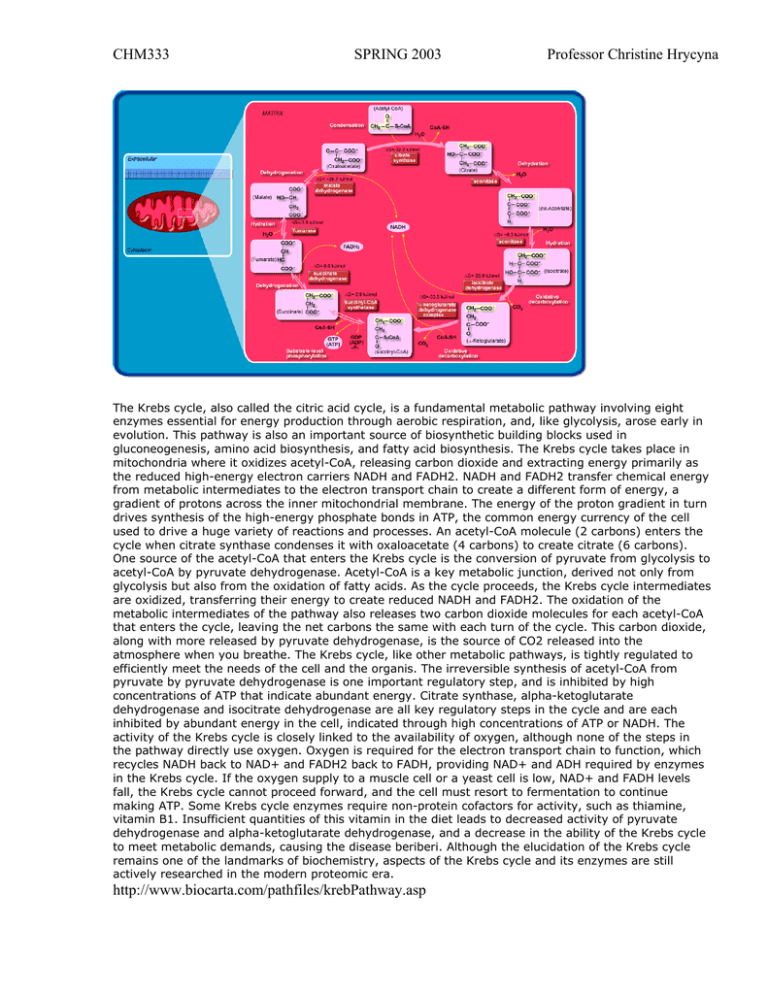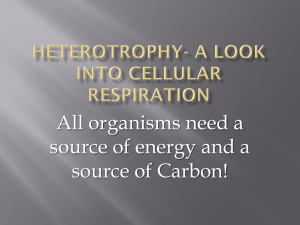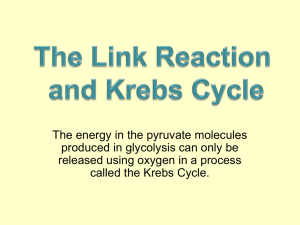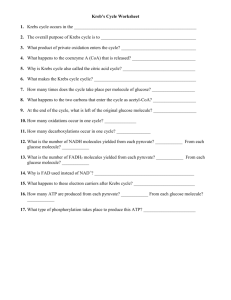Document 10296451
advertisement

CHM333 SPRING 2003 Professor Christine Hrycyna The Krebs cycle, also called the citric acid cycle, is a fundamental metabolic pathway involving eight enzymes essential for energy production through aerobic respiration, and, like glycolysis, arose early in evolution. This pathway is also an important source of biosynthetic building blocks used in gluconeogenesis, amino acid biosynthesis, and fatty acid biosynthesis. The Krebs cycle takes place in mitochondria where it oxidizes acetyl-CoA, releasing carbon dioxide and extracting energy primarily as the reduced high-energy electron carriers NADH and FADH2. NADH and FADH2 transfer chemical energy from metabolic intermediates to the electron transport chain to create a different form of energy, a gradient of protons across the inner mitochondrial membrane. The energy of the proton gradient in turn drives synthesis of the high-energy phosphate bonds in ATP, the common energy currency of the cell used to drive a huge variety of reactions and processes. An acetyl-CoA molecule (2 carbons) enters the cycle when citrate synthase condenses it with oxaloacetate (4 carbons) to create citrate (6 carbons). One source of the acetyl-CoA that enters the Krebs cycle is the conversion of pyruvate from glycolysis to acetyl-CoA by pyruvate dehydrogenase. Acetyl-CoA is a key metabolic junction, derived not only from glycolysis but also from the oxidation of fatty acids. As the cycle proceeds, the Krebs cycle intermediates are oxidized, transferring their energy to create reduced NADH and FADH2. The oxidation of the metabolic intermediates of the pathway also releases two carbon dioxide molecules for each acetyl-CoA that enters the cycle, leaving the net carbons the same with each turn of the cycle. This carbon dioxide, along with more released by pyruvate dehydrogenase, is the source of CO2 released into the atmosphere when you breathe. The Krebs cycle, like other metabolic pathways, is tightly regulated to efficiently meet the needs of the cell and the organis. The irreversible synthesis of acetyl-CoA from pyruvate by pyruvate dehydrogenase is one important regulatory step, and is inhibited by high concentrations of ATP that indicate abundant energy. Citrate synthase, alpha-ketoglutarate dehydrogenase and isocitrate dehydrogenase are all key regulatory steps in the cycle and are each inhibited by abundant energy in the cell, indicated through high concentrations of ATP or NADH. The activity of the Krebs cycle is closely linked to the availability of oxygen, although none of the steps in the pathway directly use oxygen. Oxygen is required for the electron transport chain to function, which recycles NADH back to NAD+ and FADH2 back to FADH, providing NAD+ and ADH required by enzymes in the Krebs cycle. If the oxygen supply to a muscle cell or a yeast cell is low, NAD+ and FADH levels fall, the Krebs cycle cannot proceed forward, and the cell must resort to fermentation to continue making ATP. Some Krebs cycle enzymes require non-protein cofactors for activity, such as thiamine, vitamin B1. Insufficient quantities of this vitamin in the diet leads to decreased activity of pyruvate dehydrogenase and alpha-ketoglutarate dehydrogenase, and a decrease in the ability of the Krebs cycle to meet metabolic demands, causing the disease beriberi. Although the elucidation of the Krebs cycle remains one of the landmarks of biochemistry, aspects of the Krebs cycle and its enzymes are still actively researched in the modern proteomic era. http://www.biocarta.com/pathfiles/krebPathway.asp






